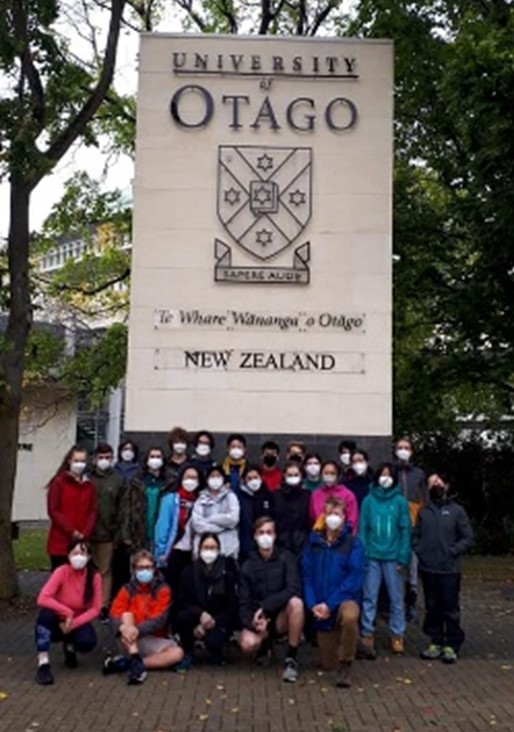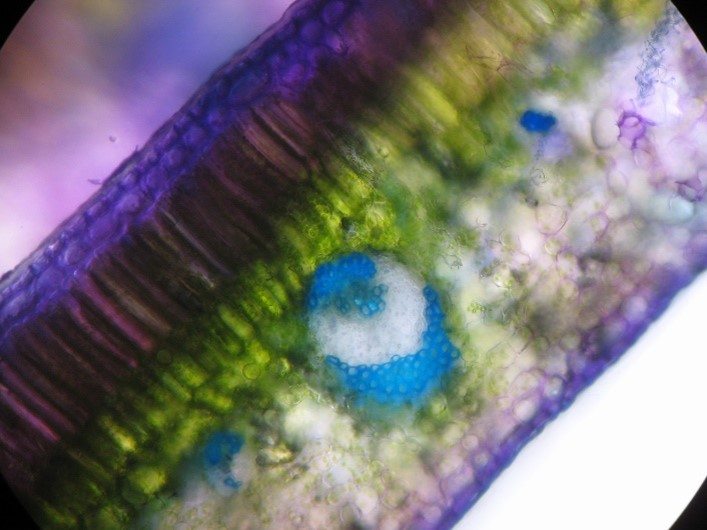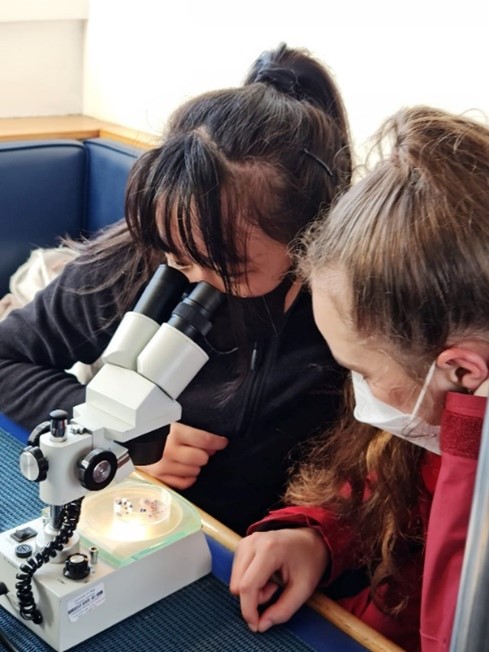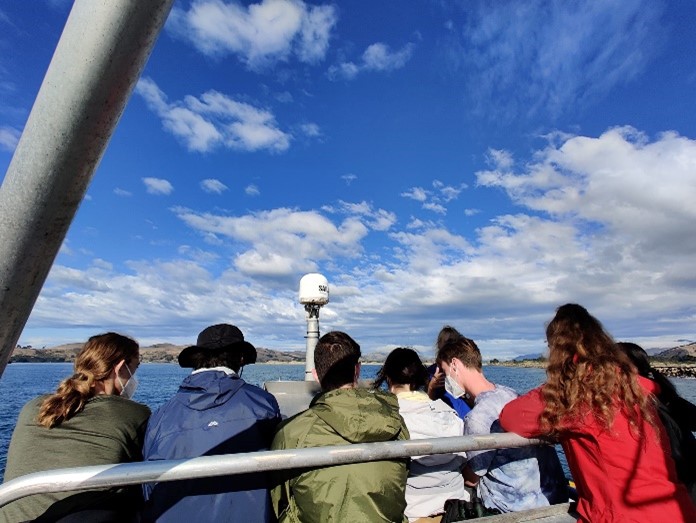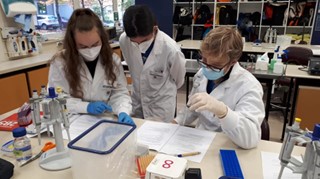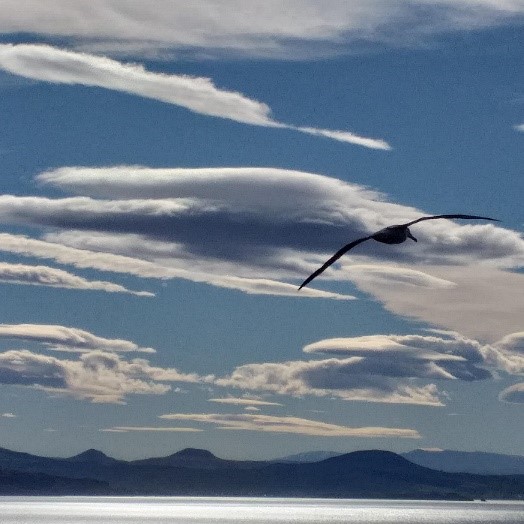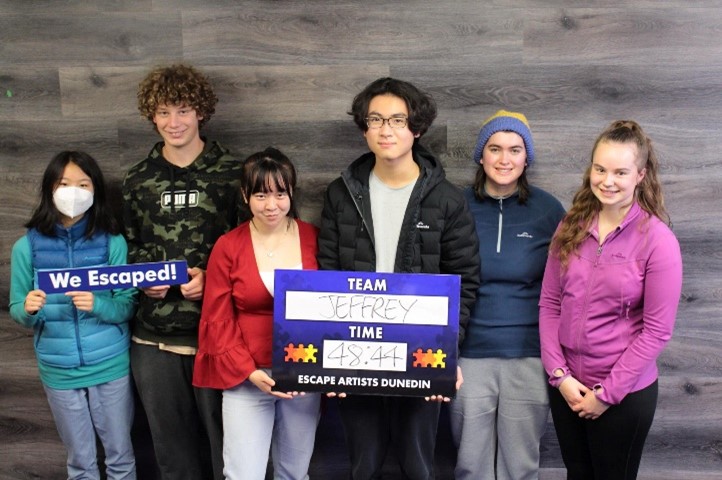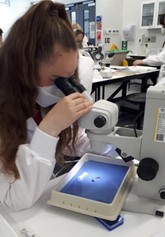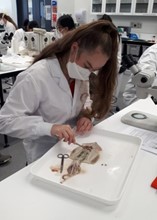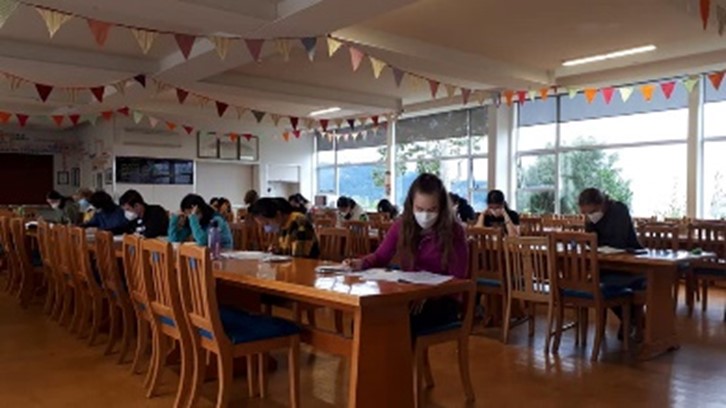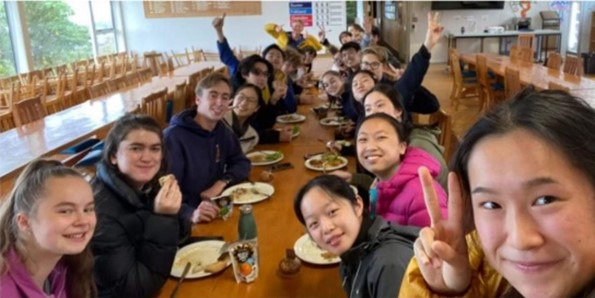Day 1 (Monday 18th April):
The first day of the NZIBO was the Monday of the second week of my holidays. My flight left Christchurch Airport at 11:50am so I arrived at the airport around 10:30am. This was the first time I had flown alone so I was quite nervous. Once I boarded, I immediately met the other NZIBO participants who were also from Christchurch, Isaac Heap from Christ’s College, and Carol Khor from Burnside High School. The flight to Dunedin took about an hour so we arrived at 12:50pm. A shuttle had been pre-arranged for us to get to the Hostel where we were staying. When we arrived at the Tolcarne Lodge (St Hilda’s boarding house), all the other NZIBO participants from other parts of the country were already there. Due to Covid-19 being active throughout the country, we had to do a Rapid Antigen Test to ensure we did not have Covid so we would not endanger anyone else or the activities we would be doing. After that, we played some introductory games and began to settle into our new rooms. I was sharing a room with Hannah Wilson from Raphael House Rudolf Steiner School from Wellington. We had a late lunch provided by the hostel and then we gathered for our first official meeting together. We met our NZIBO leaders and did some more introductory activities. Then, Liam introduced the mousetrap game. We were placed in pairs and one person was blindfolded and the other had to guide them through a minefield of set mousetraps and shoes to retrieve the lollies. The point of the exercise was to develop trust between the pairs and therefore, create a sense of trust amongst the group. After the other introduction talks, we had some free time before dinner at 6pm. As it was the first night, we had no activities after dinner, so Hannah and I decided to prepare for the next and then have an early night.
Day 2 (Tuesday 19th April):
The next day was our first day of actual NZIBO activities. We had to be ready for to leave on the bus at 8am. I had mostly packed my bag the morning before, so when I went to breakfast at 7am, all I needed to do was make my lunch. We left on the bus and drove to Aramoana. We walked along and around the beach spotting and talking about different animals and sea creatures. After, we went to the bird observatory and did bird counts in groups. We walked back to the bus and had lunch on the beach. When we drove back to the hostel, we got told we had a short time to prepare for the scavenger hunt. We were placed in groups and told we had to find some places/things, photograph them with ourselves and a token item and be at Buddha Stix by 5:50pm. We left the hostel at 2:50. Our group got most of the places/things, but we ran out of time to go all the way to Darwin Street (steepest street). We were all at Buddha Stix for a dinner at 6pm. However, the service was quite slow, so we were unable to leave the restaurant until 8:30pm. Once we had left, we had to walk up the hill back to the hostel which took at least 15 minutes. We were supposed to have some presentations that night but due to the late dinner, it was moved to another time. However, we did get our Otago University of lab coats which was quite exciting because I felt like a real scientist.
Day 3 (Wednesday 20th April):
On Wednesday, we again had breakfast at 7am and made our lunches. We then walked down the hill into town and then to the Department of Botany which is one of Otago University’s laboratories by 9am. We learnt about several types of leaves and their adaptations to living in their particular environments. After that we did some leaf dissections and investigated the cross sections under a microscope. We were also able to use a computer program to discover what percentage of the leaf cross section was a vacuole and thus make assumptions about its preferred environment. We wrapped up our dissections and left the laboratory by 1pm. After leaving the laboratory, we walked to another University building for a half hour AGRI Innovations lecture. Following this we walked to the botanic gardens and got a tour of their nurseries. It was very interesting because they had a wide variety of plants that you might not expect a nursery, particularly at the bottom of the South Island, to have. When we had seen everything, we walked back to the hostel. Dinner was as the hostel at 6pm. After dinner, we had a flower and fruit dissection lab. We learnt how to dissect flowers and how to count how many sepals, petals, stamen, and ovules a plant had. This helped us to be able to classify various plants based on their characteristics. This lab ended with us eating ice cream with an assortment of fruit which we had studied.
Day 4 (Thursday 21st April):
Again, we had breakfast at 7am but today we had to be on the bus by 8am to drive out to the University of Otago’s Marine Laboratory which is in Portobello. We were briefed and then we went out on the boat. We left at 9am and were back at the laboratory by 12:30pm. During the trip, we inspected several types of microplastics and discovered that there are a lot of different types of microplastic. Early on in the trip, we dropped a BRUV camera which videoed all the fish swimming under it. Later in the trip, we picked the camera up. We also did come bird counts from the top of the boat which was cool. The group who went up before us saw a couple of albatrosses, but unfortunately, by the time we got up we had missed them. We also took a dredge sample and got to see all the different sea creatures that live on the bottom of the ocean. Another sample we took was a phytoplankton and zooplankton sample which we analysed when we got back to the laboratory. When we got back to the laboratory, we had a break for lunch. After lunch we analysed the phytoplankton and zooplankton sample by each taking a sample and then, identifying the types of plankton we found. Following that we watched the BRUV video we had collected and did a max species count to find the abundance of each species. Once that was finished, we took the bus back to the hostel for dinner at 6pm. That evening a professor of statistics came to give us some help with the biostatistics part of our biological knowledge.
Day 5 (Friday 22nd April):
On Friday, breakfast was at the same time and at around 8am, we walked down to the University of Otago’s Department of Biochemistry and Genetics. From 9am until 10:30am, we used an excel spreadsheet to determine which mutated gene was causing the unknown disorder in a child with two normal parents. I really enjoyed this activity because it was very satisfying to discover the cause of the disorder. We took a short break and at 11am we began the process of making a Western Blot. The purpose of this is to discover whether the gene that you believe is causing the disorder is actually the causing the disorder. This process was very interesting, but you also had to be very precise as we were using micro millilitres of solution. This sparked my interest in potentially pursuing a career in some form of genetics. During times when we were waiting for solutions to be warmed or stirred slowly, we had a couple of talks. Firstly, about the new specialist science degree in PharmSci. This was interesting because it was all about the science of creating pharmaceutical products. We also had a lecture from a postgraduate student doing genetics. She explained to us about what she was doing for her studies and the different patients and diseases she was trying to discover the causes of. This furthered my interest in genetics, because it was satisfying to know that scientific theory can be applied to real world situations. Once we had finished our Western Blot, we went back to the hostel for dinner. That evening, we had two men working in the biology industry come to talk to us. One was working with bees because bees are very important in our ecosystem, and we need them to keep our crops alive. He was able to trace the genetics of all the bees and can now suggest to beekeepers where they should get their new bees. The other man was from a company called Blis. Blis has been working to create products for people with bad breath and for relief from throat illnesses. Blis uses good bacteria and introduces them onto you tongue and helps to keep your breath nice. At the end, he gave us some lozenges to take away and try for ourselves.
Day 6 (Saturday 23rd April):
After our breakfast, we got on the bus and travelled out to Allans Beach. We got to see some sea lions and we had to investigate their diet. We did this by collecting their poo and vomit. We then had to sift through it to find any bones or anything that had not be digested. From this we could come to conclusions about what the sea lions were eating. We also got to watch the sea lion mother and their pups play in the puppy pool which was very cute. After this, we got back on the bus and travelled to the Royal Albatross Centre. Before we went in, we ate our lunch in the sun with the view which was very nice. We were split into two groups, one group to watch the movie and the other to observe the albatross. I was in the movie group first. As I had been to the Centre before, I had already watched the short film. However, it was still very informative. After watching the short film and learning about the albatross, we went up to the observatory to see the birds. From the observatory we were able to see four fluffy chicks sitting in their nests waiting for their parents to come back and feed them. We were told that we would be unlikely to see any adult albatross flying but just before we were going to leave some of the albatross chick’s parents came back. We were able to see them soar with their 3m wingspan past the observatory which was very cool. As we were walking back down to the Albatross Centre, one albatross flew right over our heads which was amazing. We got back into the bus and travelled back to Penguin Place. Again, we were split into two groups. Our group travelled in the van down to the area where the penguin huts were. Unfortunately, we did not get to see any Yellow-eyed penguins, but we did see a few Little Blue penguins in their huts. We also saw some fur seals. When we travelled back to Penguin Place, we go to see the Penguin Hospital where injured or sick penguins stayed. In the hospital, we did get to see some Yellow-eyed penguins which was incredible. After this we travelled back to the Otago University campus and got a tour of one of the halls of residence. This particular hall was St Margret’s College. We got to see all the facilities and what a room looked like. Following this, we had some seminars from some postgraduate students about what they are doing for their PhDs. Once they had all presented, we had a pizza dinner with them and had a chance to talk to them and ask them questions about what they were studying and how they were enjoying their study. At 9pm, when we had finished, we walked back to the hostel.
Day 7 (Sunday 24th April):
As was usual by now, breakfast was at 7am. After this, we had some talks from a couple of NZIBO alumni who were also helping out with looking after us. This was from Liam and Nikita. They both explained to us what they were doing since their time in the Biology Olympiad and what they were studying at Otago University. They also explained why we should go to Otago University, how there are more options than just Health Science and how a degree and postgraduate studies work. After this, we walked down to Otago Museum. Even though the last time I was at Otago Museum, I really enjoyed it, this time I did not. This was because we had to complete an activity by answering lots of questions about habitats and specific animals. However, much of this information could not be found in the Museum so we had to spend most of our time on our phones. This also meant that we did not have enough time to explore the Museum for ourselves and we did not even end up presenting our work back to the group. Following this, we walked to Otago Boys’ High School where we had lunch. Then, we used the OBHS lab to do some microbiology. Unfortunately, some of the equipment that had been ordered had not arrived, so we were not able to do everything that was planned. We ended up finishing early and walking back to the hostel. This night, we had dinner early at 5:30pm. This was so that we had time to walk back down to town to do an Escape room. Our group name was ‘Jeffrey,’ and we were able to escape with in 48 minutes and 44 seconds. This was the first escape room I had done, and I really enjoyed it, especially all the puzzles and cracking locks. Once all the groups had escaped, we walked back to the hostel.
Day 8 (Monday 25th April):
On Monday, it was ANZAC day, so Hannah and I decided to get up early to watch the Dunedin Dawn ANZAC Service. This was at 6:30am. Due to the ANZAC service, breakfast was slightly later, and not until 7:30am. However, we still all ended up on the bus by 8am on our way back to Portobello and the University of Otago’s Marine Laboratory. Over the course of the day, we did six dissections. We each did a cockle, squid, earthworm, and crab individually and a spiny dogfish and other fish in groups of about six. As we did each dissection, we were told about that creature, and we had to identify various parts of that animal or fish. I really enjoyed the spiny dogfish and other fish because by then I had gotten over the sliminess of the creatures and was just really interested in the biology of the fish. It was wonderful to have the opportunity to do this, with university level equipment, because I had not done this before. Once we had completed all the dissections and cleaned up, we drove back to the hostel for dinner at 6pm. After dinner, we had a briefing about the practical exam we would have the next day and were then given free time which I used as extra sleeping time.
Day 9 (Tuesday 26th April):
On Tuesday, breakfast was one hour earlier than usual due to our practical exam. This meant that we were on the bus travelling back to the Marine laboratory by 7am. Our practical exam started at 8:45am and was 3 hours long so ended by 11:30am. In this exam, we had to do many things that we had been taught on the camp, but also use some of our general skills to follow instructions. For example, there was a BRUV video analysis, a dissection, a leaf cross section, a biostatistics section, a flower dissection, and a genetics section etc. I tried to attempt every section with more success in some areas than others. However, I gave my best and am happy with my effort, even if I do not know what my score was. After the exam, we had lunch and then were dropped off by the bus driver at the Department of Anatomy building. Here we had a one-hour developmental lecture about embryos and what happens when they form. After this, we were able to look around the anatomy museum at all the different preserved organs and bones they had. It was amazing but also quite sad, particularly the preserved embryos and infants. Following this, we walked just down the street to the Department of Zoology and got given a tour of their facilities. When this finished, we walked back to the hostel for dinner. Similarly, to the night before, after dinner, we had another briefing about the theory exam and then were given time to study or sleep.
Day 10 (Wednesday 27th April):
On the last day, breakfast was at the normal time of 7am as we were sitting the theory exam at the hostel. The theory exam began at 8:30am and like the practical exam, was 3 hours long so finished by 11:30am. The theory exam had two parts. The first part was true or false questions, and the second part was multiple choice. Again, I gave the exam my best shot and answered every question. Even though I did not get into the New Zealand Biology Olympiad team, I am very happy with how I did in the exams even though I will never get to know my results because I did my best. At the exam, we had our last meal together as the 2022 NZIBO camp group. At 12:45pm, we did our farewells for everyone and said thank you to all the adult helpers. After that everyone started leaving on shuttles. As the Christchurch flight left last, we were the last to leave the hostel in our shuttle. Our shuttle left the hostel at 3pm. Our flight was at 5:25pm and we got back to Christchurch by 6:30pm.
Reflection:
I am very privileged to have been able to go on the NZIBO camp. It was the first time that I have been away from home by myself with people that I don’t know. I would like to thank my school, St Andrew’s College, support giving the opportunity to even take the entrance exam, and then supporting me once I had got in. Thank you for also supplying me with the Campbell textbook and funds to participate. It is an experience I will never forget. I hope that as the first person from my school to make it to the camp stage, I can inspire and help other StAC students in their love of biology to pursue the Biology Olympiad. I would also like to thank Otago University and the many lecturers who gave up their time to speak to us and teach us about their area of expertise, as well as the ability to use the university grade equipment. I know that many of the lecturers have terribly busy schedules, especially during these Covid times, so thank you for being able to fit us in. Finally, I would like to thank the adults who spent the whole or part of the 10 days with us, looking after us. I know that you all had other things you could be doing, but the whole camp would not have worked without you, so thank you.


